|
Issue 1, March-Apri1 1997
NOTES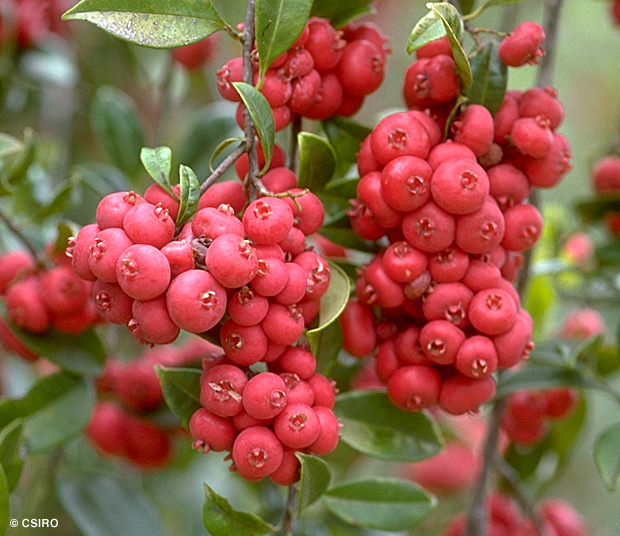
The cover plant this issue is Syzygium
fibrosum (Rain cherry) - which is not the riberry. The Riberry is Syzygium leuhmannii.
However, what most people call the Lilly pilly is in fact Acmena smithii.
Confused? Read on...
It's easy to imagine that the vast range of
Lilly pillys are all Syzygiums of one sort or another but in fact the Lilly
pilly proper is Acmena smithii. Many if not most of the twenty or so species of
Syzygium are commonly called Lilly pilly and Acmena shares a number of features
with this larger brood; they are small to medium sized trees with an ornamental
habit, eye catching pink-purple leaf flush, a sweet to tart fruit, a moderate
to fast growth rate and a good name for jams and jellies.
Acmena smithii is not on the 'top ten' list
of bushfoods but a number of Syzygiums are being pursued with enthusiasm.
S. leuhmannii (the Riberry) is definitely
flavour of the month (though some would say there are Syzygiums with a superior
fruit).
Description
The Riberry grows naturally in an area from
Kempsey in NSW to Cairns, Qld, usually found in littoral, riverine and
subtropical rainforests. It will tolerate a wide range of soil types but seems
to flourish in coastal areas. It is not an especially frost tolerant species.
The riberry can be slow to establish if it
is not receiving adequate nutrients and moisture - flowering and fruiting can
take anything between 2-6 years.
Fruit
The cream coloured flowers appear from
September to February according to climate and aspect and harvest is between
October and April.
There is usually one seed in the light pink
to red fruits, which have a unique flavour and a definite acid 'tang'.
There is a large variability in flavour
between trees.
Seedless varieties are now being avidly
sought by growers and balancing taste/seedlessness/hardiness and yield is a
challenge.
Propagation
As mentioned, the seedless variety is now actively
sought after. Syzygium reproduces readily from seed but cutting grown (clonal)
trees ensures genetic quality of the parent tree.
Grafting and top-working seedlings onto
inferior stock is an area which needs research.
Tissue culturing may be the only way to
meet existing demand for superior stock.
Planting/Yield
Minimum suggested size of planting to
avoid inbreeding is 20-40 trees.
Greatest yield is obtained .from plantings
in full sun and the heaviest fruiting will be on the sun side. It takes well
to a light shaping prune after fruiting.
Larger, mature trees (40 years plus) can
yield up to 60-70 kg of fruit (still leaving 20-40 in the inaccessible top
halt) but a more realistic yield (at year 7) would be 12-16kg per tree pa.
Pests and Diseases
The Riberry appears relatively pest-free
but has some susceptibility to scale pests
* soft brown scale (Coccus hesperidum)
* pink wax scale (Ceroplastes rubens)
The fruit fly (Dacus spp) is a potential
pest.
Harvest/Post Harvest
Riberry is a 'soft' fruit and bruises
easily. Harvesting by hand is predominant although some 'semi mechanised'
methods may be in use (adaptations of grape or coffee harvesting machinery is
a possibility). Immediate cold storage is necessary (5° for short duration
storage). It can be transported in plastic bags insulated in polystyrene. It
freezes well and drying is another option. It is a world class processing fruit
and this, along with its unique taste, ensures a good commercial future.
References from work by:
Peter Hardwick
Brett Robinson
Michael Delaney
Paul James
Vic Cherikoff
\ Mike Sheppard and
Jan Sinclair
What are Bushfoods?
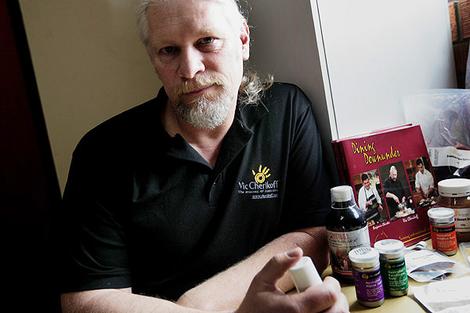 Vic Cherikoff Vic Cherikoff
For some, bushfoods area culinary bridge
between two cultures; for others they are strictly a crop; they are also on
ideal form of 'semi commercial' revegetation, an environmental experiment, an exciting
and uniquely Australian cuisine, a health food, a cuisine. In this issue, Vic
Cherikoff gives a splendid overview of the industry.
Bushfoods:
The world depends upon eight plant species
for the majority of its food supply. None of these is native to Australia. Our
current food production methods are invariably biologically simple and are
dependent upon artificial chemicals, major capital investment, etc. Bushfoods
offer us an opportunity to diversify our food production systems.
At present, over 500 restaurants
incorporate bushfoods in their menus. Bushfoods are featured in many airlines
in-flight meals, on luxury cruise ships, in Parliament Houses, Australian
Embassies overseas and many international hotel restaurants through Asia. There
have also been minor incursions into the US and European markets.
The range of bushfoods selected by Bush
Tucker Supply Aust. as commercial species is documented as having been or
still being in use by the Aborigines as food, thus complying with the WHO/FAO
definition for bushfoods as foodstuffs of a discrete population. This is
relevant to future export markets if challenges are made as to whether the new
products qualify as foodstuffs. However, toxicology issues will need to
continue to be addressed, particularly with international regulations changing.
In the development of the bushfoods
industry, education of potential growers, manufacturers, end users and
government has been necessary.
We have the opportunity knocking at our
door We have to choose whether to open the door or move house. It means stepping
into the unknown.
Growers have not had any previous
experience to follow. For example; optimal plant densities, suitable
selections, harvesting methods and post-harvest requirements have all had to be
identified, tested and refined. Research is needed to determine the appropriate
companion plantings for bushfood species and the practicality of mixed
plantings for pest control and efficiency of harvest.
The bushfoods currently supplying the
market come from a mix of some wild collections and, more significantly,
harvests from organically grown species. There may be a new production
classification.
Two could be applied. The first, native
quality - refers to organically grown indigenous species harvested from mixed
system plantings. A subgroup may become necessary if some species are
organically grown in a monoculture system in an ecologically sustainable way.
The second classification is wild quality
and two sub-groups may also be necessary here. One would apply to opportunistic
wild harvesting and a second made to the regular collections made by Aboriginal
communities
Vic Cherikoff has been credited with
pioneering the development of the bushfood industry and a native Australian
national cuisine. Through his commercialisation and promotion of a section of
bushfood species for innovative chefs,
our native foods are now finding enthusiastic acceptance in Australia and
around the world.
However, there are threats looming. Just
as the Australian native macadamia nut is now known as the Hawaiian nut to most
the world, many other Australian bushfoods are currently being researched as
commercial crops by overseas workers.
These include quandong, desert limes,
lillypillies and wattles. Desert honey ants are being evaluated for production
in the US and Australia's competitive edge on the world emu market may already
be lost.
Nevertheless, after years of ridicule or
dismissal, the concept is now being discussed (and trialled). The final stage
is widespread acceptance and use.
BTS Aust was the world's first bushfood
distribution company. It not only had to develop supply lines, but test
products, develop standards, create markets and educate customers with
entirely new and innovative products.
Australian natural wild flavours.
Most of them are best applied in small
amounts due to their flavour concentration.
For this reason, the range of bushfoods currently considered commercial is more akin to herbs than to conventional
fruits or vegetables in their culinary use.
Bushfood production provides an opportunity
to redress the shortcomings of conventional agriculture; windbreaks, shelter
belts, buffer zones and home paddocks can include productive native species or
can be used for on-farm foraging to supplement farm income.
There are many points to consider in
growing native species for bushfood, including (but by no means exhaustively):
- is the local species economic? (some bushfoods are good forage but may not be commercially significant.)
- can a viable production system be based
exclusively on native species?
- what indicator plants give an indication of
the local environmental features?.
- what species are necessary for ecological
sustainability?
- what are efficient methods for harvesting?
- what species are best to use as pioneer
species?
- how will future expansion be accommodated?
- how densely can the plants be spaced?
- where are your markets and how will these
be developed?
The 36 bushfoods (in over 200 forms)
distributed by Bush Tucker Supply Australia have been used by niche market
gourmet food producers as wild flavours in ice-cream, biscuits, chocolate,
pasta, smallgoods, preserves, sauces, chutneys, relishes, bread, cordial and
tea. Supplies are now available in sufficient quantities for mainstream
manufacturers
of breads and herbal infusions to use them in a wide spectrum of processed
products. Two supermarket lines are Goodman Fielder's Bush Breads of Australia
and Bushell's native herbal range. A few bushfood companies have their
products in Coles stores and there is much more to come this year. Post harvest
quality standards within the bushfoods industry are being investigated in
response to demands by manufacturers. Specifications for each bushfood
ingredient have been produced to define quality, flavour strength,
availability, applications, useage rates, storage recommendations, pack sizes
and nutritional information. Continuous raw material development and
refinement of purity is ongoing and microbiological assessment is conducted
where necessary. The development of the Australian bushfoods industry is unique
as few countries can offer such a range of indigenous foods. Domestically, the
industry has little or no short-term competition, although, in the market
place, bushfoods compete with other gourmet foodstuffs such as blueberries,
wild rice etc.
The author of two books on bushfoods,
"The Bushfood Handbook" and "Uniquely Australian", a wild
food cookbook, Vic has spread his enthusiasm for native food flavours to
gardeners
and professional growers, foragers and foodies, cooks and chefs.
Now, through trade curriculae, he has
written, Australian Native Cuisine is being taught to apprentice chefs who
will be serving their creations to international and local audiences come the
Sydney 2000 Olympics and beyond.
Today, Vic Cherikoff runs his business in partnership with Bradley Field and a team of highly
motivated bushfood devotees
who keep BTS Aust. leading the way for the future of Australian cuisine, both
domestically and internationally.
State of the industry:
 The latest report from RIRDC The latest report from RIRDC
The following is an extract from the latest report from the Rural Industry Research and 'Prospects for the Australian Native Bushfoods Industry."
The report was compiled by Caroline Graham and Denise Hart.
(RIRDC Research paper No. 97/22)
"There is an urgent need to promote bushfoods and educate people...being a unique and exotic Australian product is
not necessarily helpful in marketing."
This 74 page report covers:
The production sector - species, costs and returns, wild harvesting.
The processing sector - current markets, annual tonnage, value added products and commercial cultivation.
Mainstream food manufacturers - cost and produce factors,species with potential for large food manufacturers and issues
Wholesale/retail sectors - pricing, demand, distribution and issues.
Complementary industries - including wine, meat and tourism
Standards.
A SWOT analysis.
and - Industry research and development needs
In the production section, it concentrates on those plant species identified by the by the Australian National Bushfood Industry as having the most potential. These are:
Bush tomato (Solanum centrale)
Davidson plum (Davidsonia pruriens)
Illawarra plum (Podocarpus elatus)
Kakadu plum (Terminalia ferdinandiana)
Lemon aspen (Acronychia acidula)
Lemon myrtle (Backhousia citriodora)
Muntries (Kunzea pomifera
Native mint (Prostranthera)
Native mountain pepper (Tasmannia)
Quandong (Santalum acumninatum)
Riberry (Syzygium leuhmanni)
Warrigal greens (Tetragonia tetratonoides)
Wattleseed (Acacia)
Wild lime (Citrus glauca)
Wild Rosella (Hibsicus sabdariffa)
Cost of Establishment:
Species Plants/hectar x $ Total $/hectare
Bush tomatoes 8000 x $1.50 $12,000.00
Muntries 2000 x $1.50 $3000
Warrigal greens 3000 x $1.00
$3000
Native mint 2000 x $1.50 $3000
Native herbs
8000 x $1.50 $12,000
Mountain pepper 1200 x $2.30 $2760
Lemon myrtle
625 x $2.00 $1250
Native rosella 1500 X $2.50 $3750
Quandong - grafted 850 x $14.00 $11,900
Quandong- seedling 850 x $3.00 $2550
Illawarra plum
275 x $2.30 $632
Kakadu plum
275 x $2.50 $687
Lemon aspen
275 x $250 $687
Riberry
275 x $2.00 $550
Wattleseed
625 x $1.00 $625
Wild lime - seedling 625 x $2.50
$1562
Example: Lemon Scented Myrtle
Year 0 - Establishment Costs -
625 Plants $1250
Mounding and/or ripping to prepare soil $450
Irrigation system $3500
Mechanical planting $480
Total $5680
Variable Costs. Year 0:
Farm maintenance and labour $4992
Fertiliser and chemicals $600
Irrigation (@ .88 per kilolitre) $2200
Operating expenses $720
$8512
Total
$14192
Anticipated returns:
Year 0
Year 1
Year 2
Year 3
Year 4
Yield per plant (kg, dried)
.5
.75
1.5
Yield/hectare
312.5
468.75
937.5
Return/hectare
$50
kg/dried
$15625
$23437
$46875
1. Pruning, weeding and maintenance at 8 hrs/wk x $12 hr x 52 weeks.
2. Fungicide + pesticide application and slashing. Two hours/hectare x 9 sasses/year x $45 an hour (includes contract labour, tractor, spray unit and slasher).
SUMMARY
The report deals largely with plant based foods but also provides an overview of animal based bushfoods.
Fourteen plant species are considered as they have definable commercial values.
Production issues are examined:
• lack of genetically improved cultivars of most species
• lack of cost effective and environmentally sound management practices to support production
• apparent over-planting of some species which may result in lowered prices unless
demand is increased
• farmgate prices which are unlikely to be acceptable to larger scale market outlets
• lack of product quality and safety information.
Eat Your Garden
Bushfoods and Permaculture join forces to give us the best of both worlds...
 by Jenny Allen by Jenny Allen
People often equate harvesting bushfoods
with wrestling crocodiles Mick Dundee style. For your own bushfood adventure,
with a touch less peril, you can grow an exciting array of edible native
plants throughout your home garden. Here are some plants that are easy to grow
with great rewards
WARRIGUL GREENS
Tetragonia tetragonoides Growing wild in every state of Australia, warrigul greens is a great substitute
for the European spinach and, in many cases, a lot easier to grow. Although it
is believed relatively little was eaten by Aborigines, it was very popular
with Captain Cook and his crew when they arrived in Botany Bay.
They ate it to ease their scurvy and were
so pleased with it they took it back to the Kew Gardens to grow. Now it is the
major native Australian vegetable to be eaten internationally.
It's a useful plant as it grows in both sun
and semi-shade, although more prolifically in the former. I let it sprawl
underneath my fruit trees, acting as a great edible groundcover. Conveniently,
it reseeds itself so my supply is continual. It is perennial although slow.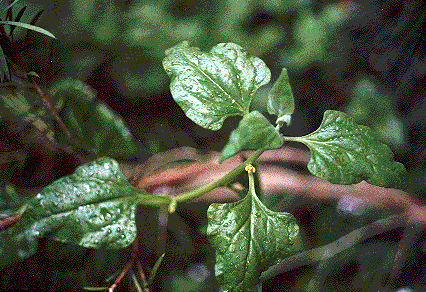
Warrigul greens can be grown from seeds or
cuttings - which you may just find at your local beach. As it grows naturally
on sheltered beaches and plains it is adaptable to the dry, although it prefers
adequate moisture. It needs a lot of nitrogen to support its leafy habit,
especially if you harvest it often. It handles frost to minus 3 and can be
harvested all year round except late winter when it has slow growth and the
seeds are setting. It yields about 1-3kg per square metre per season.
Eat the new stem, the leaves and the last 5
cm of growing tip. It does contain calcium oxalates, yet these can be removed
by blanching - don't reuse this water. Apparently, better flavoured low oxalate
forms are being developed in Europe - who knows, before long it may be
SMALL-LEAVED LILLY PILLY
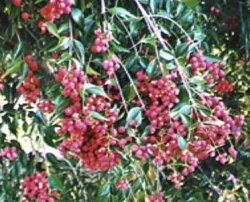 Syzygium leuhmanni Syzygium leuhmanni
The bliss bomb!!! This lilly pilly has a
spicy fruit, tasting of an interesting mix of cardamon, cinnamon and cloves!
It is a stunning tree with pink young foliage, making it a very popular street
and screen tree. Growing 5-10m, it attracts birds, is a good windbreak, is
fire retardant, can be planted along creeks and is good for erosion control.
It prefers well-drained soil and is not
frost tolerant. It can grow in both full sun and part shade although fruits
best in the former. Select trees with fruit that is seedless or has small
seeds. It fruits in 3-4 years and there has been a report of 75 kg of fruit
harvested from one tree!
LEMON SCENTED MYRTLE
Backhousia citriodora
If you want a refreshing cup of tea at your
finger tips you can't beat this beautiful myrtle. In fact, it is such a good
cleanser a friend of mine who smokes believes if he drinks a cup of lemon
myrtle tea he can have twice as many cigarettes!
It is a fast growing tree, reaching 3-8m
and enjoys full sun. It prefers a protected site and in many cases can cope
with poorly drained soil, although it relishes a well drained site with plenty
of water. It can tolerate light frosts, although is quite tender when young. It
attracts birds and butterflies and also grows well as a pot specimen.
It is better to harvest the older leaves as
they have a better texture and retain their oil better. As it has a deeper
flavour than lemon grass, with nine times its citral content, it is becoming
popular in the Asian market.
FINGER LIME
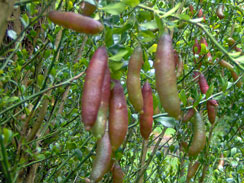 Citrus australasica Citrus australasica
The long, tangy fruit, growing up to 8cm
long, has a lot of gourmet potential. When sliced into rings it resembles
miniature cartwheels.
The finger lime bush grows 3-6m high in sun
and part shade. It is very prickly, so if you plant many together they can act
as a living fence, keeping out unwanted intruders. It is fire retardant, frost
hardy and can be planted on creeksides. It is slow growing and tolerates poor
soils provided they drain freely. It grows faster when budded onto citrus
(although it makes you wonder what the meaning of bushfoods is).
PIGFACE
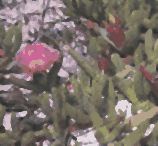 Carprobrutus glaucescens Carprobrutus glaucescens
Quite an insulting name for an ornamental
creeper with stunning flowers and interesting fruit. Plant it in full sun. As
it likes a lot of minerals, especially Potassium, Magnesium and Calcium, feed
it woodash, dolomite and rockdust.
The carprobrotus species grows commonly on
beaches, with glaucescens found in NSW and Queensland. It grows easily from a
cutting. The fruit is delicious, tasting like a slightly salty strawberry. If
it is grown away from the beach it is not so salty.
Don't eat the skin, just squeeze the fruit
and suck the end. The crushed leaves help ease the pain of sunburn, burns and
bites.
MIDYIM BERRY
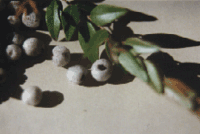 Austromyrtus dulcis Austromyrtus dulcis
This is one of my favourite bushfoods as
not only is it so tasty, it is also a versatile little plant filling in many
nooks throughout my garden. It grows I in high and I in wide and handles both
sun and part shade. It enjoys moist but well-drained soil. It is frost
tolerant, fire retardant, decorative and attracts birds. A great all-rounder.
It fruits mainly in autumn. The one cm wide fruits are white with delightful
pink spots. They have a slight ginger flavour. Fantastic snacks for the kids.
Bibliography:
Wild Food Plants of Australia -Tim Lowe,
Angus and Robertson. Notes from Peter Hardwick's bushfood courses.
Now see the Video!
Jenny Allen & Barbara
Knudson invite you to
make your backyard a
permaculture oasis
with their video
"Eat Your Garden"
$29 + S4 p&h
Phone orders: 07 5499 9442
19 Beechwood Rd Maleny
Qld 4552
Jenny runs Bushfood Workshops and advises
people how to spice up their gardens with bushfoods. |

 Vic Cherikoff
Vic Cherikoff The latest report from RIRDC
The latest report from RIRDC by Jenny Allen
by Jenny Allen
 Syzygium leuhmanni
Syzygium leuhmanni Citrus australasica
Citrus australasica Carprobrutus glaucescens
Carprobrutus glaucescens Austromyrtus dulcis
Austromyrtus dulcis